Why Did 18th Century Women Wear Such Wide Dresses
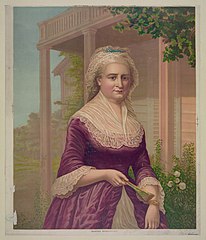
I write historical fiction based on the lives of actual women. This involves a great deal of research on the person being profiled and the world in which she lived, as well as information on events that occurred. Saxon Heroines, for example, focused on the lives of four royal women in 7th century Northumbria. Information on these individuals was sparse, and resources related to their material culture — clothing, hairstyles, medicine, diet, activities — was also limited.
My current project involves merchant women in 18th and early 19th century Salem, Massachusetts. In the process, I've discovered quite a bit about women's fashions during the period. The picture of Martha Washington on the left demonstrates a completed outfit, but it took a daily investment of time to achieve that result.
Yes, it can take an entire morning to dress.
The basic and first item of 18th century women's clothing was a linen shift. Beneath the shift, in modern parlence, women went "commando," as did men. Above the shift, there were several layers of clothing. Getting dressed, depending on the occasion, could be a lengthy process, and might require assistance.
The shift also doubled as a sleeping garment and was changed daily. Hygiene habits generally applied to washing hands and faces regularly, and perhaps other visible areas, like the neck. Otherwise, the linens protected both body and clothing.
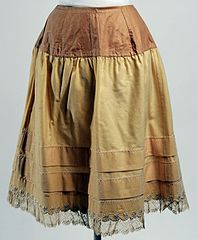
For ease, it might be best to sit down and pull on stockings first. These were made of silk, wool, or cotton and ended just above the knee, where they were tied with ribbon garters. Ribbons and straight pins, by the way, seem to be the primary method of fastening clothing.
In the case of silk stockings for dressier occasions, there could be embroidery at the ankles. These designs were called clocks, though they don't look like a clock.If the woman planned to walk or dance, she tied her stockings below the knee and rolled the upper part of the stocking down in order to further secure it.
Next, the dickey petticoat. This is a knee length garment that was worn for both warmth and modesty. In winter, it might be quilted. [The wool petticoat shown above is actually from 1888.]
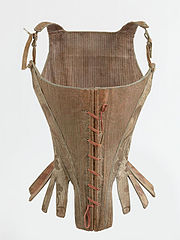
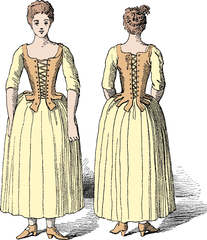
Next, stays. These created the required sillouette. They gave the wearer a flat back, narrow waist, and raised the bosom. Modern re-enactors say the stays are actually comfortable with good back and chest support. Stays were made with layers of linen and "boned" with whale baleen. They were dropped over the head, and then tied both front and back with the ribbons tied at the sides.
It's time for pockets. These pouches could be made out of any type of fabric and were often embroidered. The wearer tied a pocket on either side of her waist.
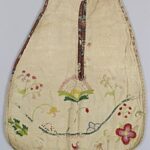
Subsequent clothing had side slits so the wearer could reach through to the pocket. Pockets could be used for many things – calling cards, money, special trinkets, keys, or anything a woman wanted to keep with her. Sometimes the ribbons holding the pocket broke, hence rymes like Lucy Locket lost her pocket / Kitty Fisher found it / Not a penny was there in it / Only ribbon round it.
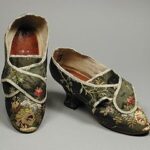
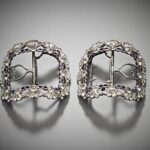
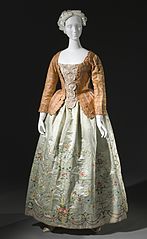
Before adding further layers of clothing, this is a good time for a woman to put on her shoes. These might be covered in plain silk or brocade and have decorative buckles.
Next, the paniers. These are hip pads that lift the skirts and emphasize the waist to make it look smaller. Alternatively, a woman might wear a fully padded petticoat. Either provided the wide-angle look of 18th century skirts.
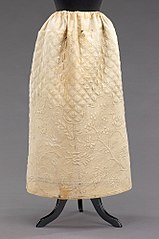
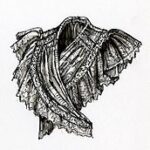
Now it's time for at least one full length petticoat. In winter there might be a wool petticoat for warmth, followed by a silk petticoat.
A fichu is added over the bosom above the shift. This provides modesty and sun protection. It could be tucked inside the gown or rest over the shoulders.
Next a stomacher. This is pinned to the stays, and fills in the front bodice of the final gown. Some are plain; some embroidered. Some are the same fabric as the gown; others are a contrast.
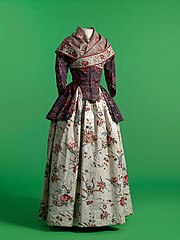
Next the gown petticoat, lined with silk or linen. This is pinned in to place in front of the stomacher.
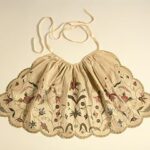
Finally, the gown itself. The gown has sleeves, and will be over the petticoat in front and next to the stomacher. The gown in this illustration utilizes a short jacket
And, last but not least, a silk or embroidered muslin apron may be added as a further means to indicate status.
This, by the way, is not special occasion wear.
Dressing for a Walk in 1811
This video gives a good example of how a lady dressed in the early 19th century. Fashion didn't undergo many changes between 1790 and 1811.
Research Results
Researching 18th and early 19th century fashion gives me a good sense of how the ladies in my current project dressed, and the length of time it took to pull oneself together. My later characters are contemporaries of the women created by Jane Austin.
It's worth bearing in mind that all women wore some variation of these styles, and that even a "lady" had chores to do.
🎀 🎀 🎀
Illustrations
Martha Washington
Petticoat 1888
Corset, 1770-1790. Jacoba de Jonge Collection in MoMu – Fashion Museum Province of Antwerp, www.momu.be / Photo by Hugo Maertens, Bruges
Illustration of corset ties, front and back ties
Brocade silk covered shoes with straps for buckles.
Fancy buckles.
Woman's striped silk sack-back jacket (caraco), Europe, c. 1760, altered c. 1780, and embroidered silk petticoat, China for the Western market, c. 1785. Public domain
Silk 'wedding' petticoat
Fichu
Jacket and shawl in chintz, skirt in glazed printed cotton, 1770-1800. Jacoba de Jonge Collection in MoMu – Fashion Museum Province of Antwerp, www.momu.be / Photo by Hugo Maertens, Bruges
Fashion Apron
Lydia Edwards. How to Read a Dress: A Guide to Changing Fashion from the 16th to the 20th Century.

Sandra's latest book, Saxon Heroines: A Northumbrian Novel, is available in eBook and print editions at Amazon, Barnes & Noble, Apple Books, Google Play and Kobo. Her previous books Two Coins: A Biographical Novel and Rama's Labyrinth: A Biographical Novel are available in print and eBook editions at Amazon, Barnes & Noble, Apple Books, Google Play and Kobo, and in audiobook editions at Amazon, Nook, Audible, Apple Books, and Kobo. Two Coins is narrated by Deepti Gupta and Noah Michael Levine. Rama's Labyrinth is narrated by Deepti Gupta.
Sandra blogs weekly about topics related to her travels, writing life, and the incongruities of life in general.
To get periodic updates, sign up for the eNewsletter or subscribe to Sandra's blog via RSS.
Source: https://www.sandrawagnerwright.com/an-18th-century-woman-gets-dressed/